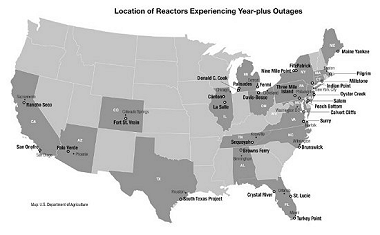Long Shutdowns Prove Nuclear Power More Dangerous and Expensive than Necessary
Sponsors
<-- Right-to-Know or Left-to-Wonder?
<-- MapCruzin News
Source: Union of Concerned Scientists - Download Walking a Nuclear Tight Rope: Unlearned Lessons of Year Plus Reactor Outages
New Report: Long Shutdowns Prove Nuclear Power More Dangerous and Expensive than Necessary -
Neglect of Safety Costs Ratepayers, Stockholders $82 Billion

WASHINGTON, DC, Sept. 18 - A new report by the Union of Concerned Scientists (UCS) shows that severe problems have caused U.S. nuclear reactors to shut down 51 times for a year or longer. More than 70 percent of those outages were caused by programmatic breakdowns that led to cumulative, systemic degradation of reactor components. Basically, the owner's failure to find and fix problems caused safety margins to deteriorate to levels so low that reactor operations could not continue. The study finds that the year-plus outages resulting from this poor management and ineffective regulatory oversight have cost ratepayers and stockholders nearly $82 billion in lost revenue.
Sponsors
"Nuclear power is clearly not safe enough when so many reactors have to be shut down for a year or more," said David Lochbaum, author of the new report and director of the Nuclear Safety Project at the Union of Concerned Scientists. "The Nuclear Regulatory Commission tolerated unsafe conditions until they became too serious to ignore. Regulators must address the safety problems in the current generation of nuclear plants before allowing utilities to build new ones."
The UCS report, Walking a Nuclear Tightrope: Unlearned Lessons of Year-plus Reactor Outages, is the first study to analyze every U.S. nuclear power outage lasting a year or longer. According to the study, 36 of the 51 year-plus outages were caused by "excessive tolerance" by the Nuclear Regulatory Commission (NRC) of plant owners who did not identify problems early enough or address them effectively. Twenty-two percent were necessitated by the replacement and repair of large components, while eight percent were the result of events that caused extensive damage to the plants. Year-plus outages account for nearly 135 reactor years (or 3.4 reactor lifetimes) of downtime at nuclear power plants.
"A one-in-three chance of incurring a year-plus outage was not supposed to be part of the bargain when these plants were built and licensed," said Lochbaum. "Some proponents of nuclear power have justified all these safety problems by arguing that no U.S. nuclear plant has experienced a meltdown since 1979. That's as fallacious as arguing that the levees protecting New Orleans were fully adequate prior to Hurricane Katrina by pointing to the absence of similar disasters between 1980 and 2004."
Federal regulations require nuclear plant owners to have quality assurance (QA) programs that find and fix problems promptly. But the recurring theme of year-plus outages has been inadequate QA programs. An accompanying theme has been the NRC either being unaware of the QA program deficiencies or knowing but not requiring improvements.
Sponsors
"In the weeks and months leading up to the start of a year-plus outage, the people living nearby face an unnecessarily high risk of an accident that could release radiation," said Lochbaum. "The Nuclear Regulatory Commission must undergo fundamental change or it will only be a matter of time before additional reactors will suffer through year-plus outages - or worse, a nuclear accident."
The report includes six recommendations to protect public safety. Among them, UCS calls on the NRC to follow federal regulations to identify and fix problems in a timely manner. The NRC must also alert plant owners about non-hardware problems and expand its oversight efforts when programmatic breakdowns are identified.
<-- Right-to-Know or Left-to-Wonder?
<-- MapCruzin News
Didn't find what you are looking for? We've been online since 1996 and have created 1000's of pages. Search below and you may find just what you are looking for.
Michael R. Meuser
Data Research & GIS Specialist
MapCruzin.com is an independent firm
specializing in GIS project development and data research.
We created the first U.S. based
interactive toxic chemical facility
maps on the internet in 1996 and we
have been online ever since. Learn more about us and our services.
Have a project in mind? If you have data, GIS project or custom shapefile needs contact Mike.
Contact Us
Report Broken Links
Subscribe for Updates
| 




